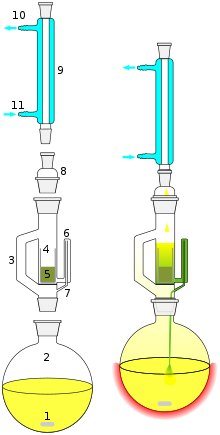
Back جهاز سوكسلت Arabic Extractor Soxhlet Catalan Soxhletův extraktor Czech Soxhlet Danish Soxhlet-Aufsatz German Εκχυλιστής Σόξλετ Greek Extractor Soxhlet Spanish Soxhleti ekstraktor Estonian Soxhlet erauzgailu Basque دستگاه استخراج سوکسله Persian

- Stirrer bar
- Still pot (the still pot should not be overfilled and the volume of solvent in the still pot should be 3 to 4 times the volume of the Soxhlet chamber)
- Distillation path
- Thimble
- Solid
- Siphon top
- Siphon exit
- Expansion adapter
- Condenser
- Cooling water out
- Cooling water in
A Soxhlet extractor is a piece of laboratory apparatus[1] invented in 1879 by Franz von Soxhlet.[2] It was originally designed for the extraction of a lipid from a solid material. Typically, Soxhlet extraction is used when the desired compound has a limited solubility in a solvent, and the impurity is insoluble in that solvent. It allows for unmonitored and unmanaged operation while efficiently recycling a small amount of solvent to dissolve a larger amount of material.
- ^ Harwood, Laurence M.; Moody, Christopher J. (13 Jun 1989). Experimental organic chemistry: Principles and Practice (Illustrated ed.). Wiley-Blackwell. pp. 122–125. ISBN 978-0-632-02017-1.
- ^ Soxhlet, F. (1879). "Die gewichtsanalytische Bestimmung des Milchfettes". Dingler's Polytechnisches Journal (in German). 232: 461–465.